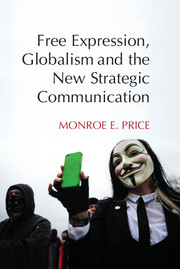Book contents
- Frontmatter
- Contents
- Acknowledgments
- 1 Moving the Needle, Filling the Streets
- 2 Strategic Communication and the Foundations of Free Expression
- 3 Narratives of Legitimacy
- 4 Strategies of the Diagnostic
- 5 Asymmetries and Strategic Communication
- 6 Strategies of System Architecture
- 7 Soft Power, Soft War
- 8 Religions and Strategic Communication
- 9 Regulating NGOs in the Market for Loyalties
- 10 Strategic Platforms
- 11 Strategic Communication and Satellite Channels
- 12 Strategies of Closure, Markers of Anxiety
- Bibliography
- Index
- References
8 - Religions and Strategic Communication
Published online by Cambridge University Press: 18 December 2014
- Frontmatter
- Contents
- Acknowledgments
- 1 Moving the Needle, Filling the Streets
- 2 Strategic Communication and the Foundations of Free Expression
- 3 Narratives of Legitimacy
- 4 Strategies of the Diagnostic
- 5 Asymmetries and Strategic Communication
- 6 Strategies of System Architecture
- 7 Soft Power, Soft War
- 8 Religions and Strategic Communication
- 9 Regulating NGOs in the Market for Loyalties
- 10 Strategic Platforms
- 11 Strategic Communication and Satellite Channels
- 12 Strategies of Closure, Markers of Anxiety
- Bibliography
- Index
- References
Summary
Religious groups provide an extraordinary focus for observing patterns and behaviors in strategic communication. In Chapter 1, I described how sellers of allegiances compete against one another for market share, fight to preserve their position or aggressively maneuver to enter and expand. Instances of the strengthening or weakening of a religious hold on popular modes of thinking, often across national borders, become hallmark cases of ways to influence public sentiment on matters related to significant aspects of cultural formation. Religions, and those who seek to limit or expand their influence, have the kind of consensus-shifting or basic influence-related goals I have characterized as attributes of strategic communication. They often engage with elements of belief central to the target society. Much of modern politics revolves around the extent to which certain religious actors can expand their sway, unite or separate from the political realm and increase their footprint and reach. Multiple terrains exist where efforts to expand influence are met by efforts to block such expansion, where monopolies and oligopolies over religious experience are maintained or are subject to bitter attack. Ultimately, much of this interaction, struggles to expand followed by struggles to restrict or limit, becomes a matter of communication or restraints on communication. Religious communication is associated with a transcendent force, a force with a claim to authority higher than that of other forms of speech or influence. Because it has the capacity to motivate large-scale attitudes, because it is so basic to issues of identity, religious speech raises important challenges to regulation and control.
- Type
- Chapter
- Information
- Free Expression, Globalism, and the New Strategic Communication , pp. 153 - 175Publisher: Cambridge University PressPrint publication year: 2014



